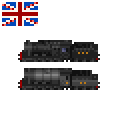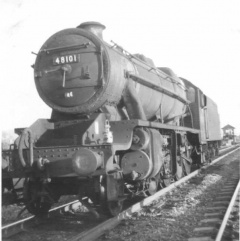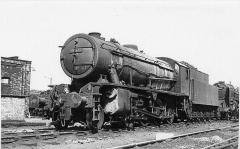Stanier 8F
| (4 intermediate revisions by one user not shown) | |||
| Line 34: | Line 34: | ||
==Prototype information== | ==Prototype information== | ||
| − | [[Image:8f.jpg|left|240px]][[Image:8fa.jpg|right|240px]]The [http://en.wikipedia.org/wiki/LMS_Stanier_Class_8F Stanier 8F] was a major break from the "small engine" policy the LMS inherited from the Midland Railway. Powerful and sure-footed, Stanier's design became the standard heavy freight locomotive produced by the government during WWII, until it was replaced by a [http://en.wikipedia.org/wiki/WD_Austerity_2-8-0 simplified "Austerity" version] redesigned by R.A. Riddles. | + | [[Image:8f.jpg|left|240px]][[Image:8fa.jpg|right|240px]]The [http://en.wikipedia.org/wiki/LMS_Stanier_Class_8F Stanier 8F] was a major break from the "small engine" policy the LMS inherited from the Midland Railway. Powerful and sure-footed, Stanier's design became the standard heavy freight locomotive produced by the British government during WWII, until it was replaced by a [http://en.wikipedia.org/wiki/WD_Austerity_2-8-0 simplified "Austerity" version] redesigned by R.A. Riddles. |
| − | Between the Stanier and Austerity versions, almost 2000 8F locomotives were produced by the workshops of all the major railways and private contractors, making them the most-produced steam locomotive in British history (and even if you don't count them as the same model, the Austerity is ''still'' the most-produced, with the Stanier in the top five). After the | + | Between the Stanier and Austerity versions, almost 2000 8F locomotives were produced by the workshops of all the major railways and private contractors, making them the most-produced steam locomotive in British history (and even if you don't count them as the same model, the Austerity is ''still'' the most-produced, with the Stanier in the top five). After the war, 8Fs were to be found working as far afield as Iraq, Scandinavia and Hong Kong. |
==Similar locomotives== | ==Similar locomotives== | ||
[http://en.wikipedia.org/wiki/GNR_Class_O2 GNR Class O2] | [http://en.wikipedia.org/wiki/GNR_Class_O2 GNR Class O2] | ||
| + | {{Sunshine}} | ||
{{PJ1K}} | {{PJ1K}} | ||
[[Category:Locomotives]] | [[Category:Locomotives]] | ||
| + | [[Category:Transport Tycoon Style (UKRS2)]] | ||
| + | [[Category:Small Selection (UKRS2)]] | ||
Latest revision as of 06:45, 30 May 2018
The 2-8-0 8F is a steam locomotive in the UK Railway Set.
[edit] Statistics and information
| Type: | Heavy Freight Steam Locomotive |
|---|---|
| Introduction: | 1933 |
| Withdrawal: | 1975 |
| Speed: | 50mph |
| Power: | 1550hp |
| Weight: | 128t |
| Tractive Effort: | 144kN |
| Replaces: | Mineral |
| Replaced By: | Star, EE Type 3 |
[edit] Prototype information
The Stanier 8F was a major break from the "small engine" policy the LMS inherited from the Midland Railway. Powerful and sure-footed, Stanier's design became the standard heavy freight locomotive produced by the British government during WWII, until it was replaced by a simplified "Austerity" version redesigned by R.A. Riddles.Between the Stanier and Austerity versions, almost 2000 8F locomotives were produced by the workshops of all the major railways and private contractors, making them the most-produced steam locomotive in British history (and even if you don't count them as the same model, the Austerity is still the most-produced, with the Stanier in the top five). After the war, 8Fs were to be found working as far afield as Iraq, Scandinavia and Hong Kong.
[edit] Similar locomotives
| UK Revival Set (UKRS3) |
|---|
| GRFs |
| UK Revival Set (UKRS3) |
| Locomotives |
|
|
| Rolling Stock |


